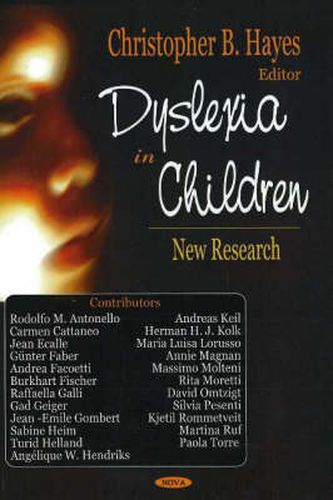Readings Newsletter
Become a Readings Member to make your shopping experience even easier.
Sign in or sign up for free!
You’re not far away from qualifying for FREE standard shipping within Australia
You’ve qualified for FREE standard shipping within Australia
The cart is loading…






Dyslexia is a brain-based type of learning disability that specifically impairs a person’s ability to read. Although the disorder varies from person to person, common characteristics among people with dyslexia are difficulty with phonological processing (the manipulation of sounds) and/or rapid visual-verbal responding. The syndrome of dyslexia does not imply low intelligence or poor educational potential, and is independent of race and social background. Although dyslexia seems to be more prevalent among males than females, the exact ratio is unknown: the most commonly quoted figures are between 3:1 and 5:1. The evidence suggests that in at least two-thirds of cases, dyslexia has a genetic cause, but in some cases birth difficulties may play a role. Dyslexia may overlap with related conditions such as dyspraxia, attention deficit disorder (with or without hyperactivity) and dysphasia. In childhood, its effects can be misattributed to emotional or behavioural disorders. By adulthood, many dyslexics will have developed sophisticated compensating strategies that may mask their difficulties. This new book presents state-of-the-art research in this dynamic field.
$9.00 standard shipping within Australia
FREE standard shipping within Australia for orders over $100.00
Express & International shipping calculated at checkout
Dyslexia is a brain-based type of learning disability that specifically impairs a person’s ability to read. Although the disorder varies from person to person, common characteristics among people with dyslexia are difficulty with phonological processing (the manipulation of sounds) and/or rapid visual-verbal responding. The syndrome of dyslexia does not imply low intelligence or poor educational potential, and is independent of race and social background. Although dyslexia seems to be more prevalent among males than females, the exact ratio is unknown: the most commonly quoted figures are between 3:1 and 5:1. The evidence suggests that in at least two-thirds of cases, dyslexia has a genetic cause, but in some cases birth difficulties may play a role. Dyslexia may overlap with related conditions such as dyspraxia, attention deficit disorder (with or without hyperactivity) and dysphasia. In childhood, its effects can be misattributed to emotional or behavioural disorders. By adulthood, many dyslexics will have developed sophisticated compensating strategies that may mask their difficulties. This new book presents state-of-the-art research in this dynamic field.